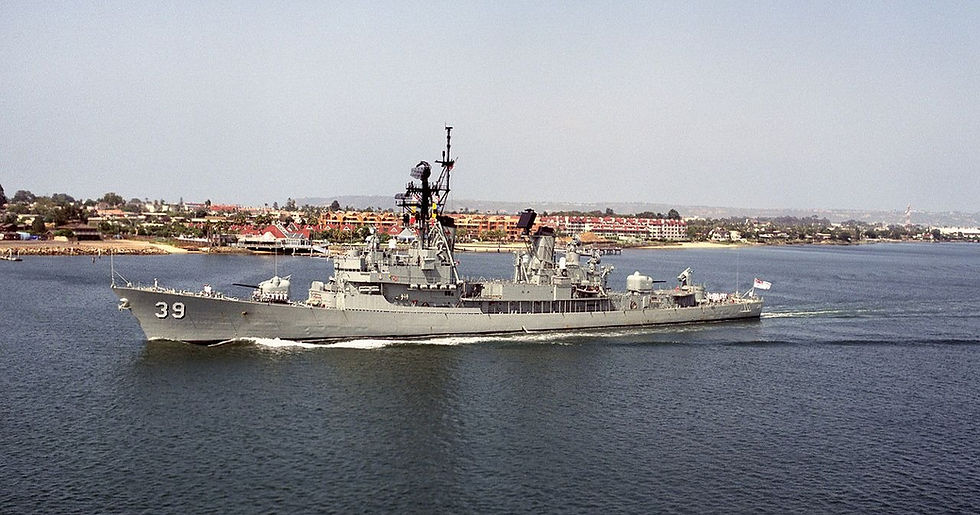HMAS Stuart DE48
- Nepean Naval Museum

- Nov 6, 2022
- 3 min read
HMAS Stuart (F21/DE 48) was one of six River-class destroyer escorts built for the Royal Australian Navy. The ship was laid down by Cockatoo Docks and Engineering Company in 1959, and commissioned into the RAN on 28 June 1963.

Stuart was paid off in 1991, a year later than originally planned; RAN commitments to the Gulf War saw several warships deployed to the Middle East, and Stuart was retained in service to boost local defence. The destroyer escort was sold for scrapping.
The first four ships of the River class were based on the Royal Navy's Type 12 frigate, and were intended to close the gap between ships and submarines in regards to anti-submarine warfare, following the rapid improvement of submarines during and after World War II.
She displaced 2,750 tons at full load, she was 112.8 m (370 ft) long, 2.49 m (41.0 ft) across the beam and had a draught of 5.18 m (17.0 ft). She was powered by two English Electric steam turbines, and was capable of 31.9 knots (59.1 km/h; 36.7 mph).
Stuart was armed with two 4.5in Mark 6 guns controlled by an M22 Fire Control Radar , she had two Limbo Mark 10 anti-submarine mortars, a quad Seacat SAM launcher, two Mark 32 torpedo tubes, and the Ikara anti-submarine missile system, the first Australian-designed naval weapons system.
Her sensors and processing systems also included the LW02 long range air warning radar, the Mulloka sonar system, SPS-55 surface-search/navigation radar, and an ELT-901 Electronic Warfare system.

Her motto was: "Semper Paratus".
During the ship's career, Stuart achieved a number of historical firsts, she was the first ship to fire an Ikara missile during trials in August 1966, and she was the first RAN ship to fly the Australian White Ensign in 25 December 1966 while operating as part of the Far East Strategic Reserve, although the Australian White Ensign did not officially replace the British White Ensign until 1 March 19673. She was also the first major vessel to be home-ported at Fleet Base West.
From late 1968 until 1969, Stuart was designated Flagship of the RAN, while the aircraft carrier HMAS Melbourne underwent a major refit.
During April and May 1970, she carried out escort duties for the Royal Yacht Britannia during the visit to Australia by Queen Elizabeth II and the Duke of Edinburgh.
Following the destruction of Darwin by Cyclone Tracy in December 1974, Stuart was one of thirteen RAN ships deployed as part of the humanitarian aid mission Operation Navy Help Darwin. Stuart sailed from Sydney on 26 December.
Stuart, along with HMA Ships Hobart, Vampire, and Supply, visited the United States in 1976 for the nation's bicentennial celebrations.
Members of the Nepean Blue Mountains Sub-Section who served on the Stuart.
Left Robert (Monty) Montgomery Right Colin (Col or Irish) O'Flynn
In 1979, Stuart entered dock to undergo a half-life modernisation refit valued at A$50 million. This included upgrades to weapons and systems, reinforcement of the hull, and improvements to seakeeping and habitability. The main improvement was the installation of the Australian-developed Mulloka sonar system. Delays and cost increases meant that Stuart did not re-enter service until 1983.
In January 1984, Stuart became the first major RAN warship to be homeported at Fleet Base West in Western Australia. Between May 1984 and September 1986, the ship was deployed to South East Asia three times.
A six-month refit began in February 1987, followed by a six-month assignment to the training squadron with HMAS Stalwart and HMAS Jervis Bay. Stuart returned to Western Australia in November 1988.

Stuart as originally intended to leave service in early 1990, but the Iraqi invasion of Kuwait saw Australia commit several Adelaide-class frigates to the United States-led Coalition. Stuart was kept in service to perform the local defence duties of the deployed frigates.
HMS Stuart inherited the following Battle Honours - MEDITERRANEAN 1940, CALABRIA 1940, LIBYA 1940–41, MATAPAN 1941. GREECE 1941. CRETE 1941. PACIFIC 1942–43. NEW GUINEA 1942–44.
HMS Stuart was paid off on 26 July 1991. She was later sold for scrapping.
Her 4.5-inch Mk V/Mk 6 gun turret is on display at HMAS Stirling in Western Australia.








Comments